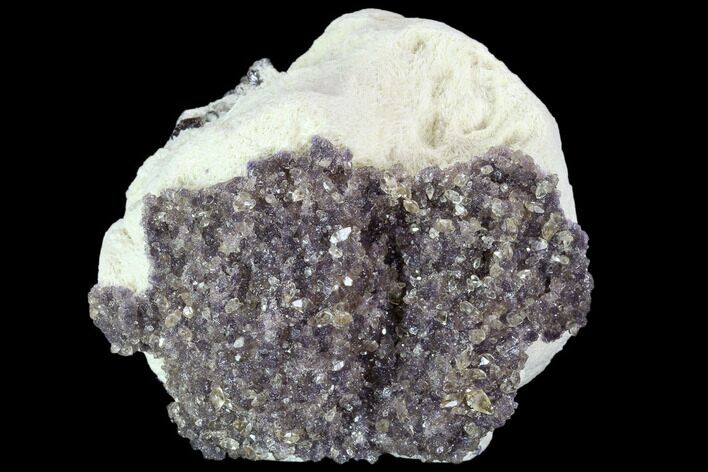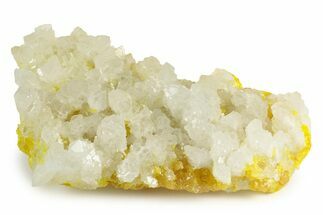This Specimen has been sold.
4.5" Fluorite, Celestine (Celestite), Calcite & Sphalerite - Tennessee
This is a beautiful specimen that contains an association of calcite, fluorite, sphalerite & celestine, collected from the famous Elmwood mine in Tennessee. The fluorite and calcite crystals are small and together they encrust a large portion of the celestine matrix. The celestine formation is fibrous and white, and seemingly holds the specimen together like a glue. On what could be considered bottom of the specimen, there are multiple sphalerite crystals. Under short wave UV, the calcite crystals fluoresce orange in color.
Comes with a display stand to assist with preferred presentation.
Comes with a display stand to assist with preferred presentation.
The Elmwood Mine
The Elmwood Mine in central Tennessee is one of the world’s premier localities for fluorite, barite, and sphalerite, producing specimens renowned for their size, color, and exceptional crystal quality. Forming within Mississippi Valley–Type (MVT) deposits, Elmwood fluorite is famous for its rich grape-purple cubes—often water-clear and stepped—with barite perched elegantly on top in creamy clusters or golden blades. The mine’s sphalerite is equally celebrated, yielding lustrous, gemmy crystals ranging from fiery orange to deep red-black. Together, these species make Elmwood one of the most iconic and collectible mineral localities on the planet, known for generating museum-grade combinations unmatched in aesthetics and mineralogical significance.
Commercial mining at Elmwood began in the late 1960s, when the site was developed as part of the larger Central Tennessee zinc district. For decades, the mine operated primarily as a major source of high-grade zinc ore for industrial use, with fluorite, barite, and collector-quality sphalerite crystals forming as spectacular but incidental byproducts of the ore-extraction process. Periodic closures and reopenings—driven by fluctuating zinc prices and ownership changes—have made fine Elmwood specimens increasingly coveted over time. Although the mine’s primary purpose was always zinc production, its unexpected yield of world-class mineral specimens has cemented Elmwood’s place as one of the most important and beloved mineral localities in North America.
The Elmwood Mine in central Tennessee is one of the world’s premier localities for fluorite, barite, and sphalerite, producing specimens renowned for their size, color, and exceptional crystal quality. Forming within Mississippi Valley–Type (MVT) deposits, Elmwood fluorite is famous for its rich grape-purple cubes—often water-clear and stepped—with barite perched elegantly on top in creamy clusters or golden blades. The mine’s sphalerite is equally celebrated, yielding lustrous, gemmy crystals ranging from fiery orange to deep red-black. Together, these species make Elmwood one of the most iconic and collectible mineral localities on the planet, known for generating museum-grade combinations unmatched in aesthetics and mineralogical significance.
Commercial mining at Elmwood began in the late 1960s, when the site was developed as part of the larger Central Tennessee zinc district. For decades, the mine operated primarily as a major source of high-grade zinc ore for industrial use, with fluorite, barite, and collector-quality sphalerite crystals forming as spectacular but incidental byproducts of the ore-extraction process. Periodic closures and reopenings—driven by fluctuating zinc prices and ownership changes—have made fine Elmwood specimens increasingly coveted over time. Although the mine’s primary purpose was always zinc production, its unexpected yield of world-class mineral specimens has cemented Elmwood’s place as one of the most important and beloved mineral localities in North America.
About Fluorite
Fluorite is a halide mineral comprised of calcium and fluorine, CaF2. The word fluorite is from the Latin fluo-, which means "to flow". In 1852 fluorite gave its name to the phenomenon known as fluorescence, or the property of fluorite to glow a different color depending upon the bandwidth of the ultraviolet light it is exposed to. Fluorite occurs commonly in cubic, octahedral, and dodecahedral crystals in many different colors. These colors range from colorless and completely transparent to yellow, green, blue, purple, pink, or black. Purples and greens tend to be the most common colors seen, and colorless, pink, and black are the rarest.
Fluorite is a halide mineral comprised of calcium and fluorine, CaF2. The word fluorite is from the Latin fluo-, which means "to flow". In 1852 fluorite gave its name to the phenomenon known as fluorescence, or the property of fluorite to glow a different color depending upon the bandwidth of the ultraviolet light it is exposed to. Fluorite occurs commonly in cubic, octahedral, and dodecahedral crystals in many different colors. These colors range from colorless and completely transparent to yellow, green, blue, purple, pink, or black. Purples and greens tend to be the most common colors seen, and colorless, pink, and black are the rarest.
Sphalerite is a part of the sulfide group and typically exhibits a grey/black appearance due to high concentrations of impurities. In its purest state, sphalerite's chemical composition is ZnS, and can display a gemmy transparent light tan/yellow color. This is one of the few minerals that can form crystals ranging anywhere between gemmy and transparent to opaque and metallic-like. Opaque or cloudy sphalerite tends to be most abundant since iron easily replaces zinc in the process of formation.
About Calcite Crystals
Calcite crystals are a form of calcium carbonate (CaCO₃) known for their diverse shapes, transparency, and vibrant range of colors. They typically form in rhombohedral, scalenohedral, or prismatic shapes, often with well-defined, sharp edges and glossy surfaces. Calcite crystals are often translucent or transparent, sometimes displaying a double refraction effect where objects viewed through the crystal appear doubled. They can appear in various colors—white, clear, yellow, pink, blue, green, and orange—depending on impurities or trace minerals.
A notable characteristic of calcite is its reaction with weak acids like vinegar, which causes it to effervesce, or fizz, as it releases carbon dioxide. This property makes calcite crystals a key tool in geological identification and studies. Calcite forms in many environments, from sedimentary rocks like limestone and marble to hydrothermal veins.
Calcite crystals are a form of calcium carbonate (CaCO₃) known for their diverse shapes, transparency, and vibrant range of colors. They typically form in rhombohedral, scalenohedral, or prismatic shapes, often with well-defined, sharp edges and glossy surfaces. Calcite crystals are often translucent or transparent, sometimes displaying a double refraction effect where objects viewed through the crystal appear doubled. They can appear in various colors—white, clear, yellow, pink, blue, green, and orange—depending on impurities or trace minerals.
A notable characteristic of calcite is its reaction with weak acids like vinegar, which causes it to effervesce, or fizz, as it releases carbon dioxide. This property makes calcite crystals a key tool in geological identification and studies. Calcite forms in many environments, from sedimentary rocks like limestone and marble to hydrothermal veins.
SPECIES
Fluorite, Celestine, Calcite & Sphalerite
LOCATION
Elmwood Mine, Carthage, Tennessee
SIZE
4.5 x 4.3" entire specimen.
CATEGORY
SUB CATEGORY
ITEM
#103961
 Reviews
Reviews














